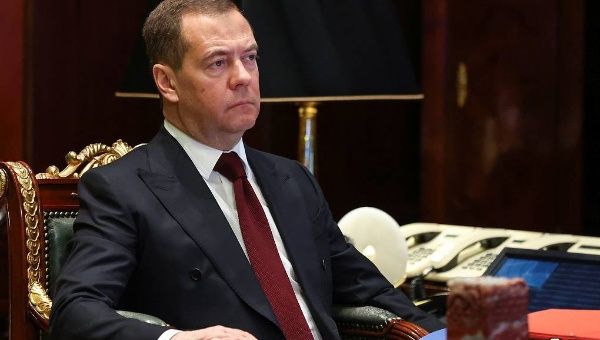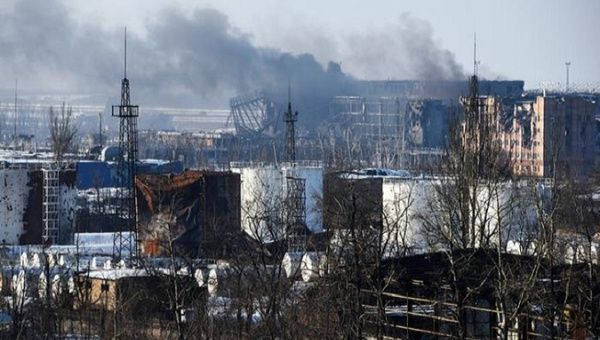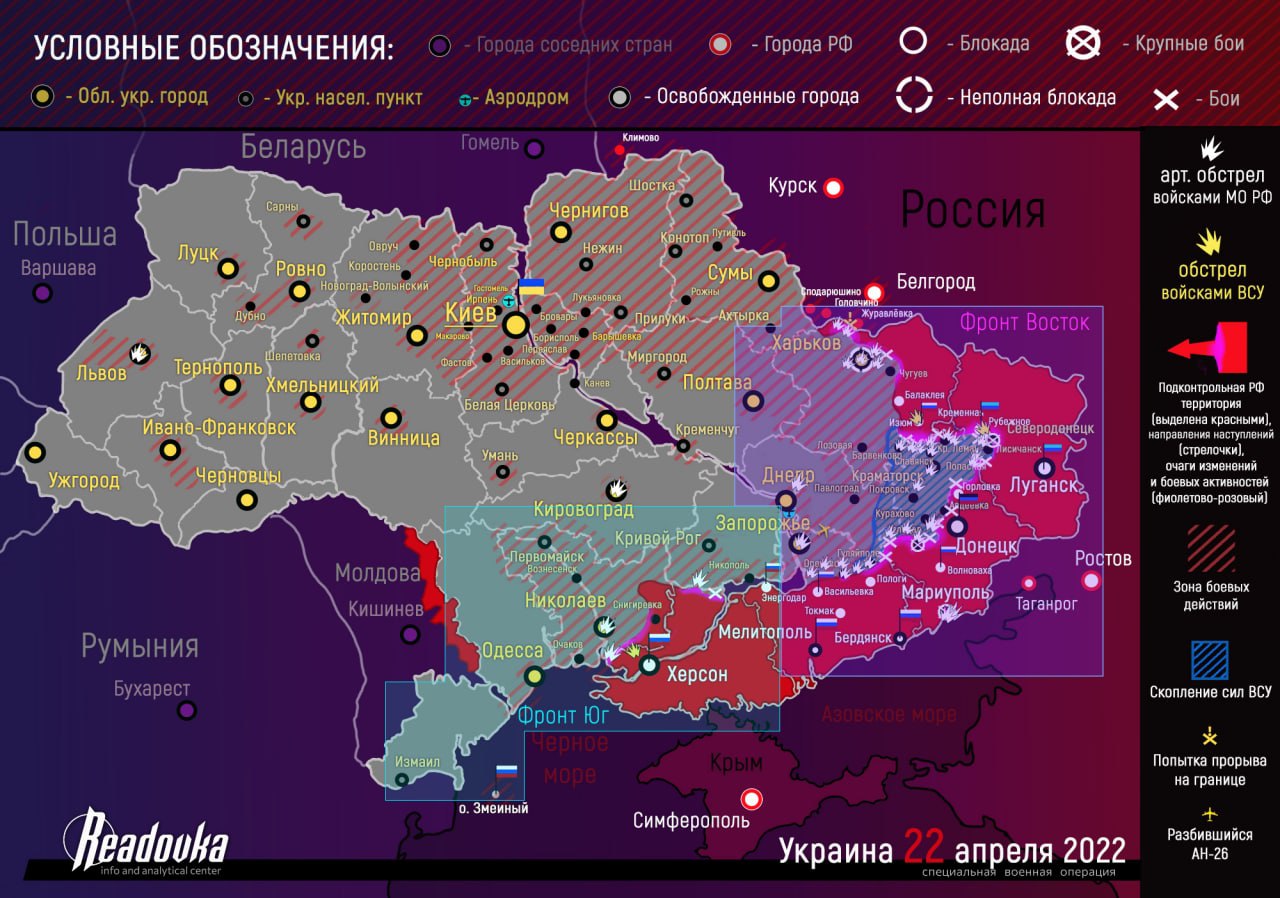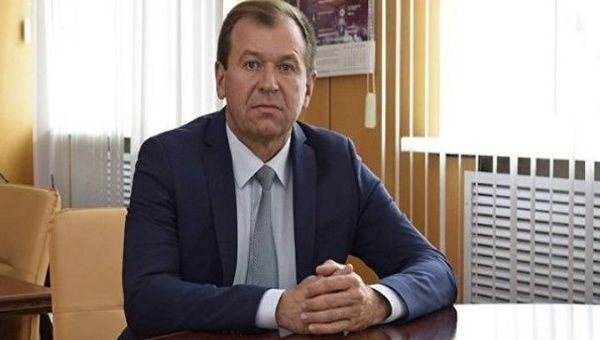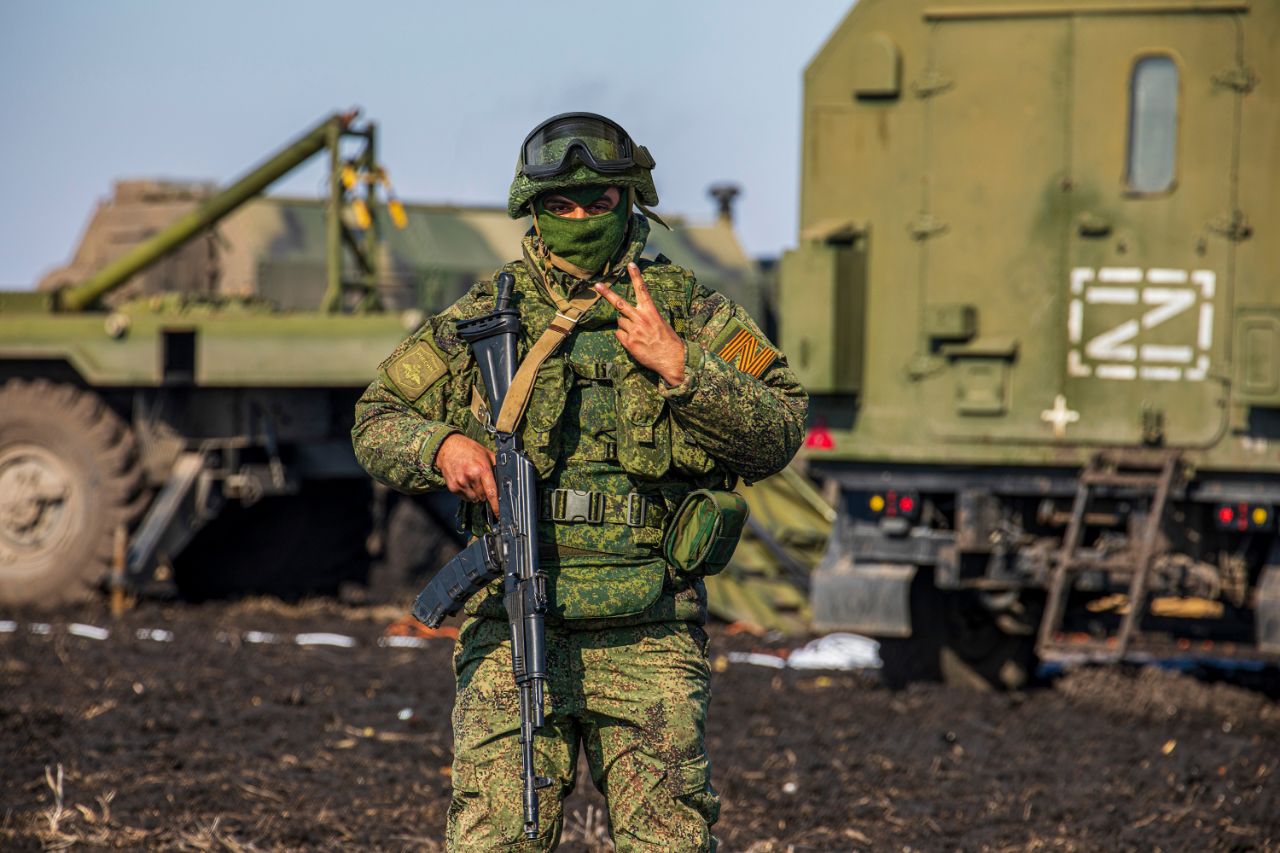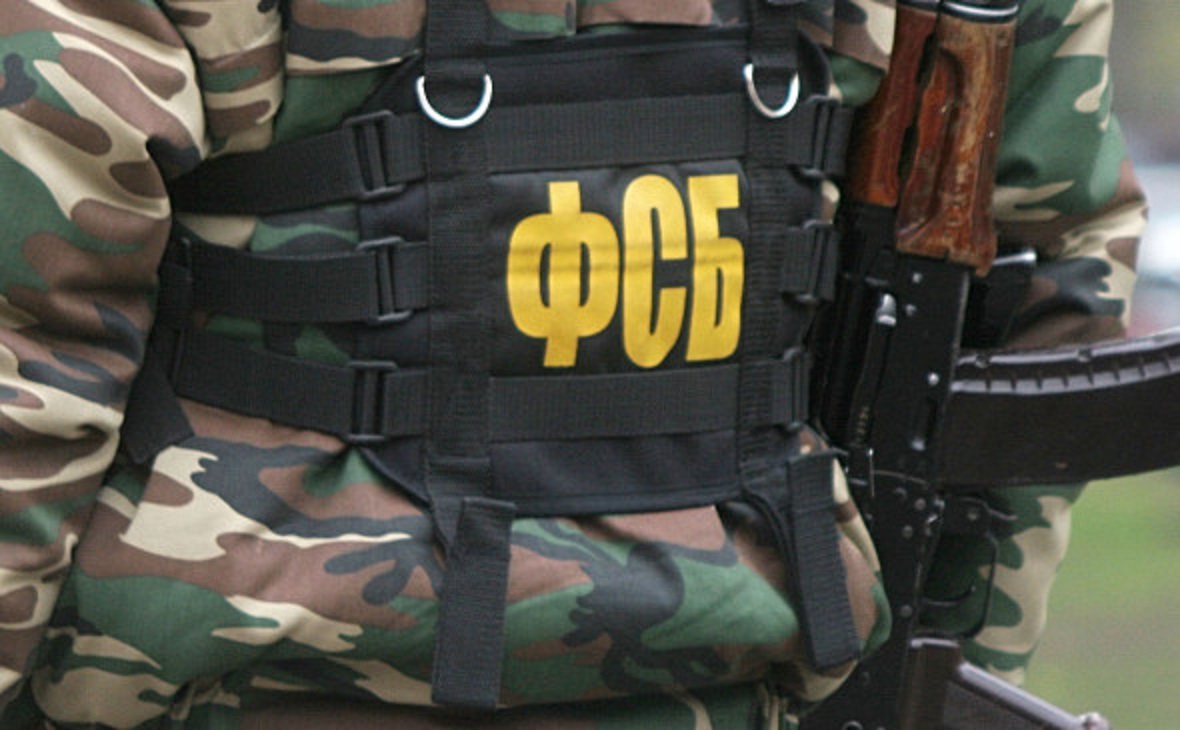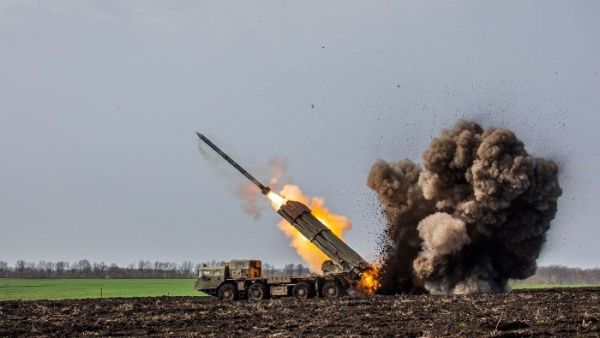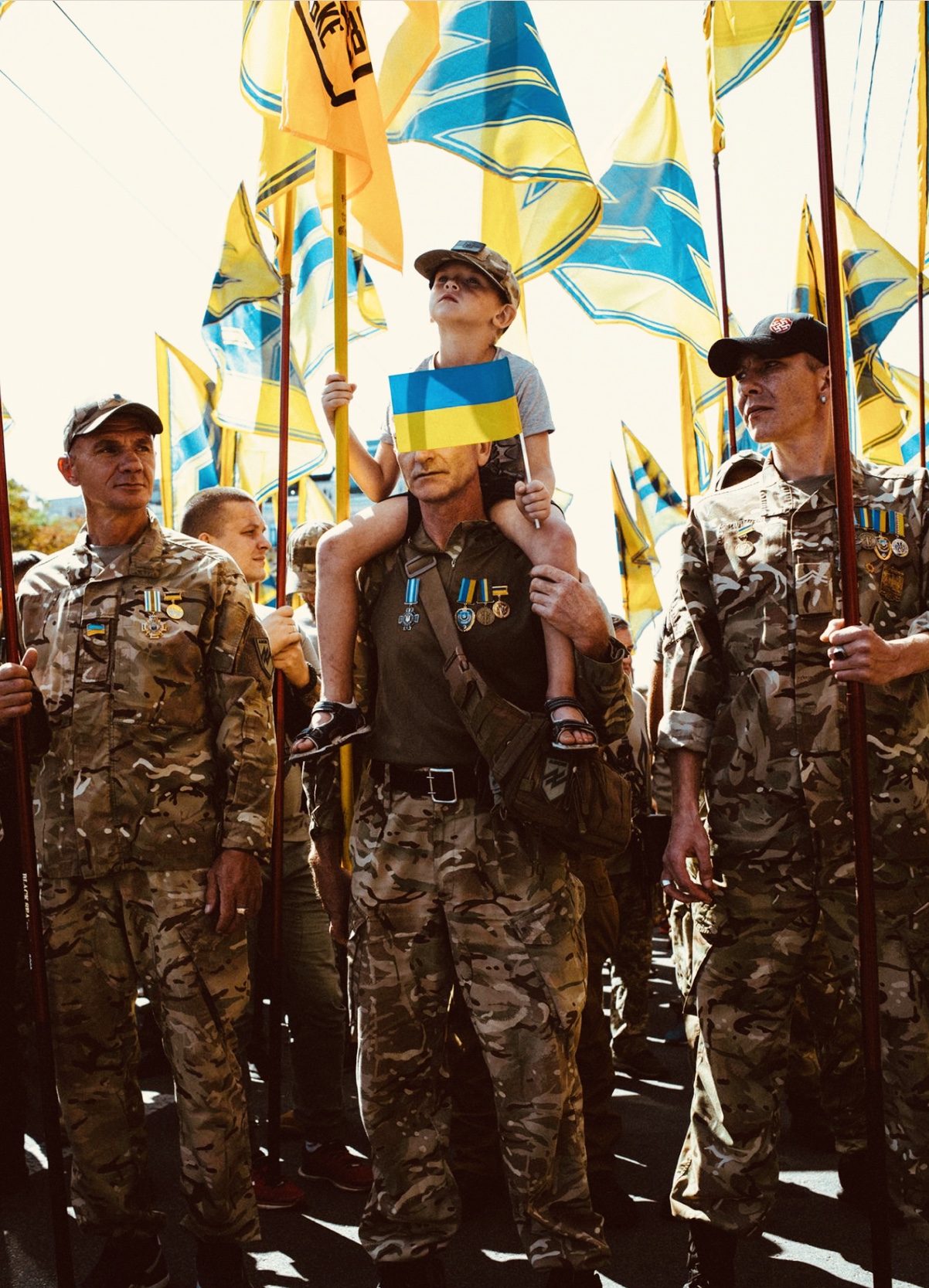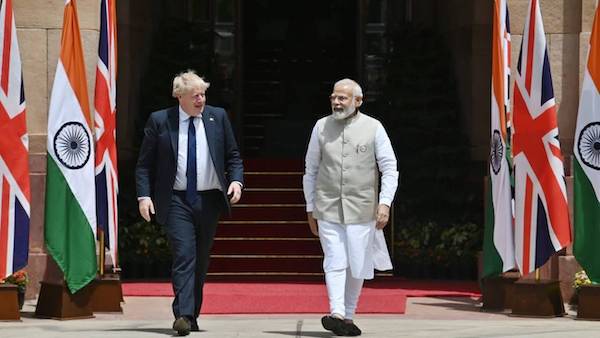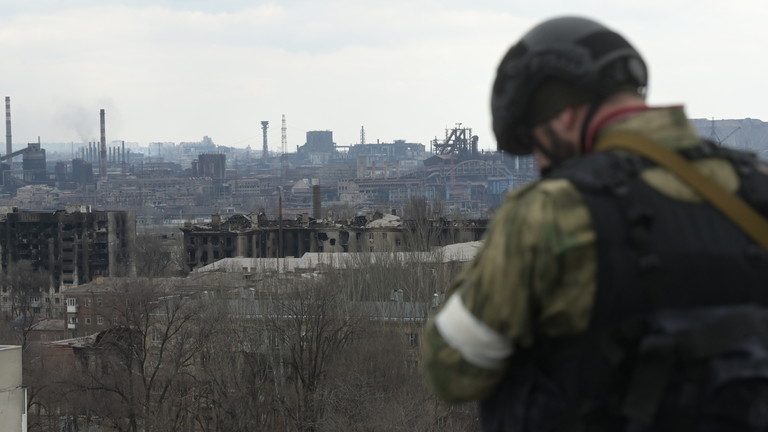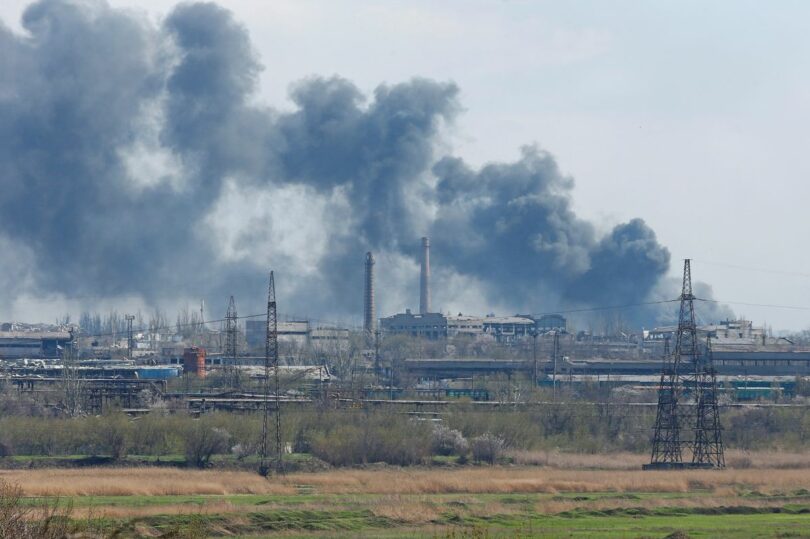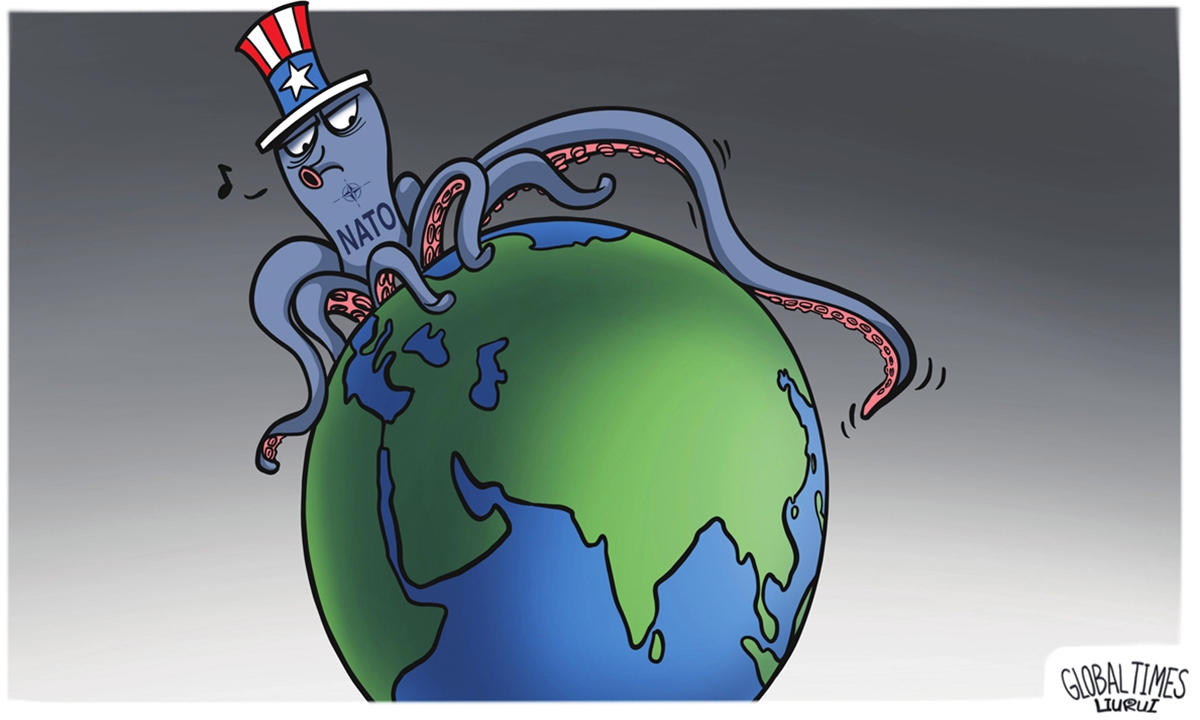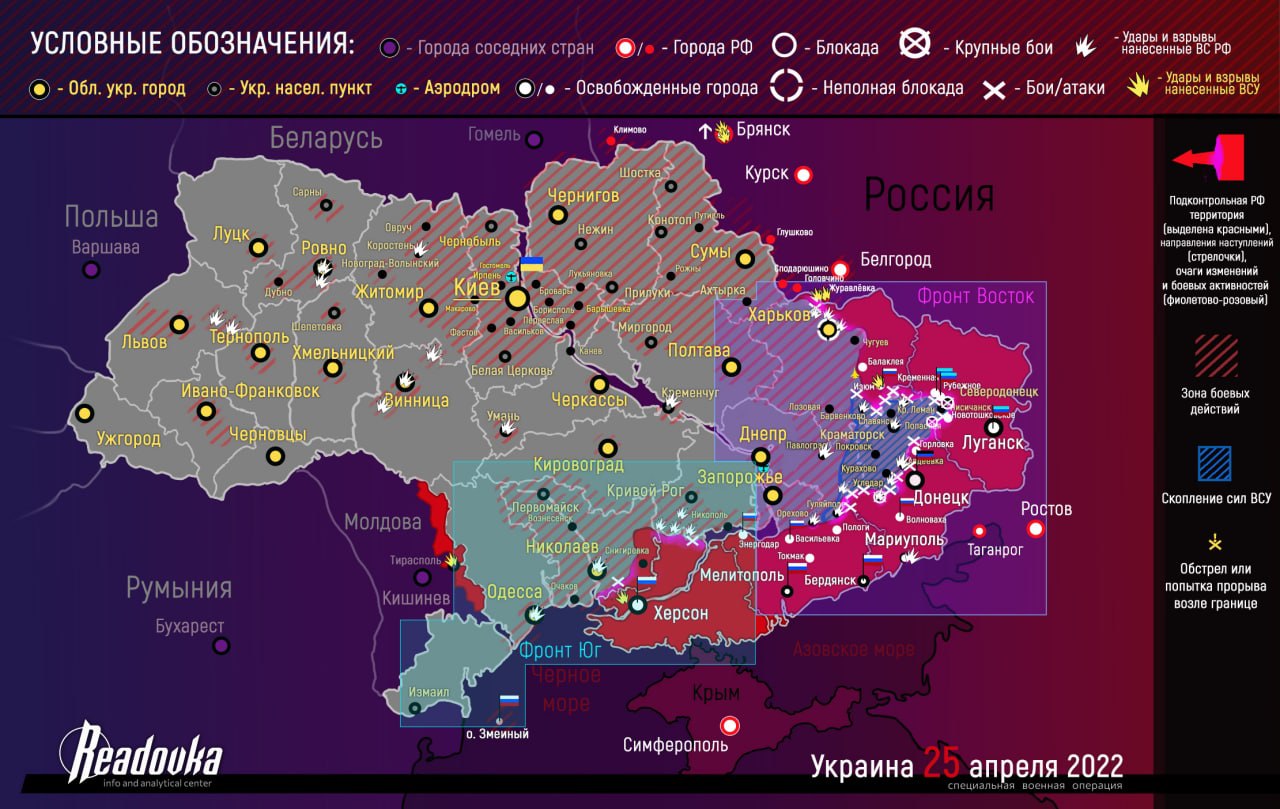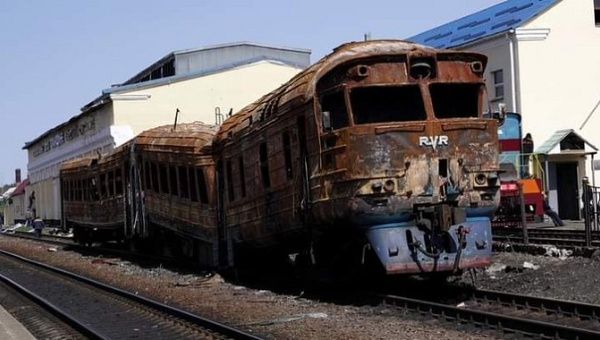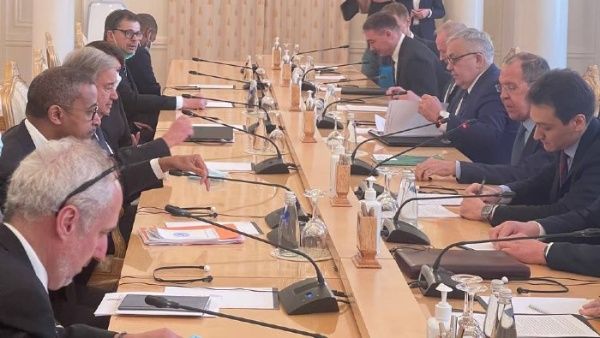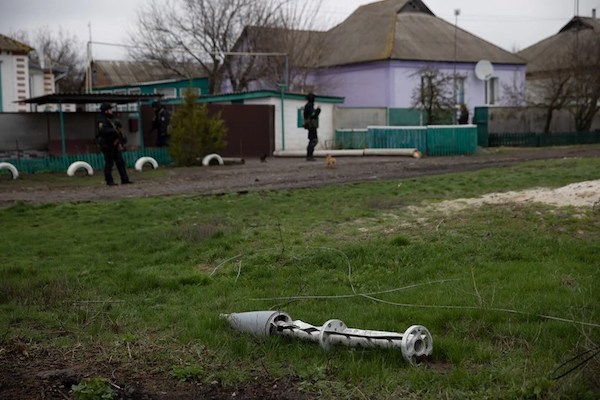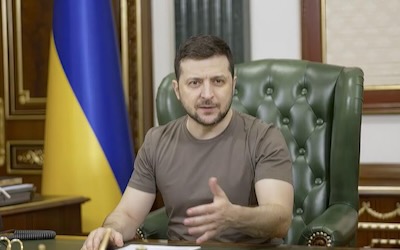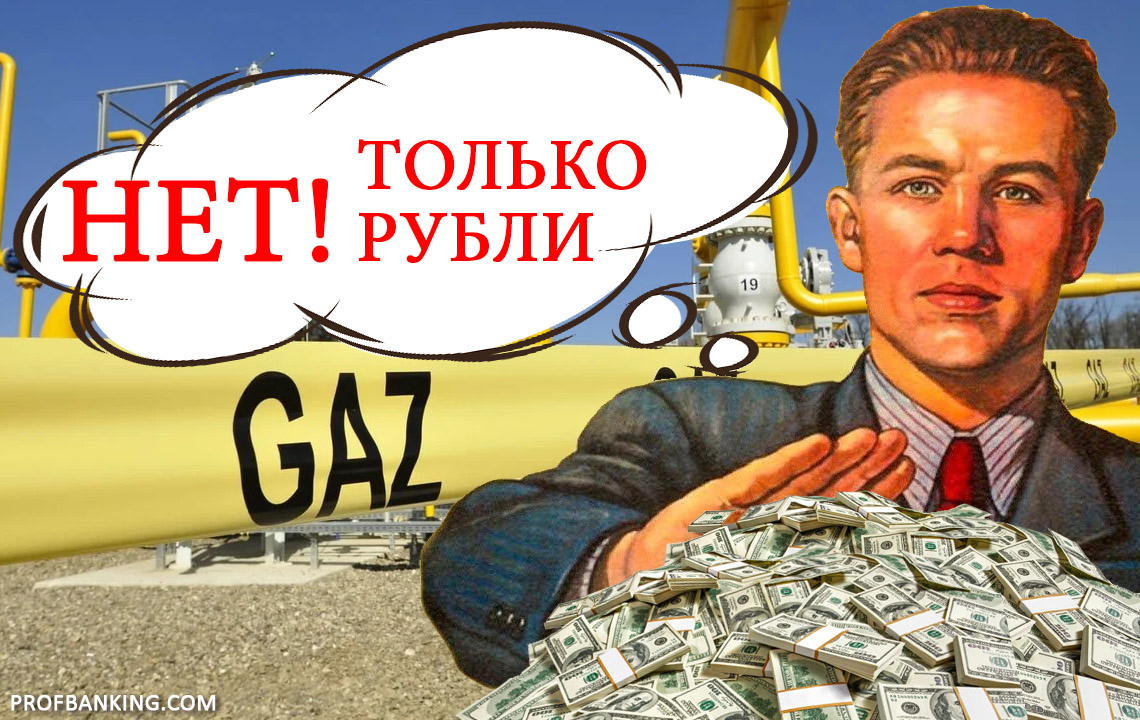1. Gonzalo Lira is alive
Lira had been arrested on April 15 by the SBU, the Ukrainian Gestapo, but is now at some private place in Kharkov under a kind of house arrest. He is not allowed to leave the city. It seems that the public attention the case had caught has helped to hold back the nastier side of the Ukrainian authorities. Last night Alex Christoforou of The Duran published a short video talk with Gonzalo Lira (vid).
2. Russia's war aims
In a talk at a defense industry meeting Major General Rustam Minnekaev, Deputy Commander of the Central Military District, named areas of Ukraine which Russia wants to secure (machine translation):
"Since the beginning of the second phase of the special operation, it has already begun, literally two days ago, one of the tasks of the Russian army is to establish full control over the Donbass and southern Ukraine," he said.
...
"This (control over the Donbass - TASS note) will provide a land corridor to the Crimea, as well as influence the vital facilities of the Ukrainian [military forces], Black Sea ports through which agricultural and metallurgical products are delivered to [other] countries," - said the deputy commander.
"Control over the South of Ukraine is another way out to [Transnistria], where there are also facts of oppression of the Russian-speaking population. Apparently, we are now at war with the whole world, as it was in the Great Patriotic War, all of Europe, the whole world was against us. And now the same thing, they never liked Russia," he added.
The Russian ambassador to the U.S. again named the political aims:
Russia’s special military operation in Ukraine is aimed at demilitarization and denazification of the country, and Moscow will ensure that the country has a non-nuclear and neutral status, Russian Ambassador to the US Anatoly Antonov said on Thursday.
3. Military supplies
Yesterday Russia attacked four railway crossing over the Dnjepr river. One in the Zaporozhye region and three in the area of Dnepropetrovsk.

This cuts off Ukrainian troops on the Donbas front east of the river from all large scale supplies.

The Ukrainian military, like Russia's, depends on railways for all long distance mass supplies as both have relatively few logistic trucks.
The U.S. and others have said they would give the Ukraine dozens of 155mm towed artillery guns plus tens of thousands of shells with them. The U.S. guns come with one truck each to tow the gun.
That is all manageable so far but now let's look at the logistics (especially without railways). A 155mm shell plus the powder needed to fire it weighs about 50 kilogram. A three axle military truck can carry 7.5 metric tons or 150 shells. That's about what one or maybe two guns will fire on a good day.
The distance from the Ukrainian border with Poland to the Donbas front is about 1,200 kilometer (~800 miles). That is at least a two days drive with a truck. The daily supplies for one gun on the frontline will thus require constant traffic of at least 6 trucks plus all the fuel needed to run them. Adding maintenance and load/unload time means even more trucks. Now multiply that with the number of guns that are supposed to come in.
This is very fast becoming a huge transport operation with lots of trucks the Ukraine does not have. So how will it get all those shells to the frontline? It won't.
4. Current operations
Since the launch of phase two of its operation the Russia military has not started any larger offensive but has increased its artillery fire on the frontline. Here is a part of the 'clobber list' from this morning's Russian Defense Ministry briefing:
Kalibr high-precision long-range missiles destroyed up to a battalion of enemy personnel with weapons and military equipment near Miliorativnoe railway station.
High-precision air-based missiles of the Russian Aerospace Forces hit 3 military assets of Ukraine.
...
Operational-tactical aviation of the Russian Aerospace Forces hit 58 military assets of Ukraine. Among them: 4 command posts, 3 fuel depots, and 51 areas of Ukrainian manpower and military equipment concentration.
Missile troops and artillery carried out 1,285 firing missions during the night. Destroyed: 9 fuel depots, 37 command posts. 1,221 strong points, areas of enemy's manpower and military equipment were hit.
One artillery firing missions usually includes multiple guns (often 6) and multiple shells (3 to 10) fired per gun. This constant incoming artillery fire will be extremely demoralizing (and deadly) for the Ukrainian troops on the frontline. (I have experienced only one artillery onslaught, during officer training and in a safe bunker. It was still extremely violent. Some of us literally wet their pants.)
The Ukrainian soldiers can only dig in, keep their heads down and hope to not receive a direct hit. Their artillery is gone. They have no way left to respond to the fire. After a few days of this the Russian troops will be able to roll them up with little difficulties.
Posted by b on April 22, 2022 at 12:40 UTC | Permalink
https://www.moonofalabama.org/2022/04/n ... .html#more
*************************************
Flags in Kakhovka
April 22, 15:38

Flags in Kakhovka, liberated from the Ukrainian Nazis.

Plus, Ilyich returned to Melitopol for his birthday.
https://colonelcassad.livejournal.com/7573260.html
Google Translator
***********************************
Russia’s Campaign in Ukraine and the West’s Response: The End of the Beginning?
Posted on April 21, 2022 by Yves Smith
While it’s impossible to predict how the war in Ukraine, which is now undeniably a proxy war between the US/NATO and Russia, will wind up, some boundary conditions for both the military and economic battle are emerging. And their implications do not look too good for the West.
Let’s make a couple of overarching observations:
Russia has to and will win the immediate military contest. Russia cannot tolerate an armed and hostile bordering country any more than the US would accept China sending troops and weapons to Canada. Russia wants a neutral Ukraine. If the only way the West will accept that is by prostrating Ukraine, so be it. Note that Russia launched its invasion with clearly stated objectives of demilitarizaton and denazification which most assuredly did not amount to conquering or occupying Ukraine. Putin also said something to the effect of “We won’t stay where we aren’t wanted” which did signal a willingness to entertain Crimea-type referenda, using the precedent the US set in Kosovo.
The US and many European countries have taken such extreme positions about the Russian invasion that it’s hard to see how they back down if [when] Russia wins. Had they not turned the dial up to 11, they would have had an easy out in depicting the Russian “failure” to take the western part of Ukraine, which Russia seems highly unlikely to attempt, as a Russian loss and a way for the US and Europe to save face.
But by having bought their own propaganda about the fundamental evil of Putin and all things Russian, including cats and Russia losing the war, the US and NATO will have no where to go when the Ukraine military collapses, which is inevitable. The Western press, by virtue of laziness and/or capture, keeps projecting a US style approach onto Russia, when by now they should know better. Russia is prosecuting a methodical grinding up of Ukraine’s military capacity and by quite a lot of measures is doing very well. Looking at territorial acquisition was and is the wrong way to assess progress.
Mind you, the West will try to look like is is Doing Something, like saber-rattling, admitting Finland and Sweden to NATO, and making promised to arm Europe. The latter project will take years and is unlike to amount to much in the light of Europe’s own deteriorating economic situation.
The US had already made clear it was not going to give up on its economic sanctions of Russia, even when its “Russia is losing” story seemed more plausible than it does now. The US justification for again looting Russia (the hoped-for outcome) even if it were defeated in Ukraine, was that it would be necessary to force the overthrow of Putin and/or the breakup of Russia (a pet idea of Zbigniew Brzezinski).
So if Russia achieves its objectives in the next month or two (mind you, cleaning up operations can have a long tail) and the Western press can’t finesse that the Ukraine military is kaput, the PR fallback might be that the Western sanctions are eating at the foundations of the Russian economy and it won’t be too long before it collapses.
The wee problem with relying on the economic barrage to succeed where a military one failed is that the sanctions and sanctions blowback/countersanctions are shaping up to be trench warfare. As Michael Hudson and others have explained, Europe and the US are more fragile than they appear. Unequal societies dependent on the labor of lowly workers who are already economically stressed are vulnerable to political upheaval when they are hit with additional fuel and food price shocks.
Russia will suffer too, but it is in a completely different position than the West. First, it was on its way to being an autarky. Second, it was warned that sanctions were coming, both directly and by how the US has gone after Iran. Its handling of the financial sanctions shows Russia had made some preparations on the banking front; we’ll see in the coming months if it made adequate provisions on the real economy front. Third, many reports from Russia confirm that Russians on a widespread regard the continued advance of NATO into Ukraine as an existential threat and will accept necessary sacrifices. Fourth, Russia came through the crucible of its 1990s collapse and was still able to regroup and recover. It seems very unlikely that Russian lifespans and living standards will fall as far as they did then. And this time, Europe will be taking body blows, so even though Russia’s absolute economic conditions will fall, its relative position might not.
Let’s look at some recent developments and see how they fit in.
The Weakening Condition of the Ukraine Armed Forces
The battle for Mariupol is not the war, but Russia has taken control of the city save technically for the remaining Ukraine forces holed up in the Azovstal factory, which the Russian Ministry of Defense recently estimated as at most 2100. Keep in mind that even though it seems as if the Mariupol clearing operation has gone on for a while, it took ten months to subdue Mosul, which had a roughly similar number of defenders (the MoD recently put the former Ukraine forces in Mariupol at 8,100 when earlier estimates by other parties were much higher; the ISIS forces holding Mosul have been pegged at anywhere between 3,000 and 12,000).
The Azovstal factory forces were clearly doomed, cut off from food, water, and fresh weapons. Russia repeatedly promised their survival if they surrendered. Russian sources claim that radio chatter revealed soldiers asking for permission to turn themselves over to Russia but Kiev refused and ordered commanders to shoot any deserters or even anyone who mentioned surrender. The Ukraine government has not commented on these accounts.
However, my understanding is both Ukraine and Russia have effectively confirmed the authenticity of the video below. The only dispute is who the speaker is. Both sides put him in the same unit; Russia also claims he is a member of the Azov Battalion:
Although this is a grim picture, it’s more or less where all the units in Donbass are headed if they don’t surrender or escape. There are numerous videos showing Ukraine soldiers using passenger vehicles. That means they are pretty much out of tanks and military vehicles.
Note this odd video Jerri flagged a few days ago in Links (sorry we can’t embed it):
“SPASIBA JOE BIDEN FOR THE HUMMERS!” https://www.bitchute.com/video/G1HMTwSk6OH5/
This is from the Illych factory in Mariupol, another of the Azov Battalion last stands, which the Chechens captured last week.
One wonders, or maybe not, why so many Hummers are sitting around. The arms-savvy likely know that the Hummer was a failed experiment. It was a Jeep on steroids, which a higher wheelbase and independent suspension so it could handle even rougher terrain. But like the Jeep, it was not clad. In the Middle East, they kept being blown up by mines, to the degree that the Pentagon had to be persuaded to retrofit their bottoms. History Hit drily comments that Hummers were not well suited for urban combat. They made for easy targets.
The ones in the factory do look dusty, as if they were put in service. But how did they get there in the first place? Were they US castoffs that Ukraine concluded weren’t fit for purpose for them either?
The plural of anecdote is not data, but this segment is even more puzzling:
CHECHENS ENTER FIRST PART OF AZOVSTAL FACTORY – FIND GOODIES
What are three tanks doing sitting around, particularly since the only one you can see well looks way too clean, as if it has been little used? Perhaps PlutonimKun had the answer:
The Ukie tanks will never go one on one with Russian tanks for a simple reason – their ammunition is out of date and can’t penetrate modern Russian armour. This is a very well known limitation of their standard gun. Nato can’t help as it doesn’t make armour piercing shells of the right calibre for the Ukie tanks.
Let’s widen the lens. The Ukraine army is pretty much out of gas. We linked to a Ukraine business site saying more than a week ago that only 1/3 of the gas stations were open. As Louis Frye confirmed:
UA no longer has any functional refineries…supplies have to be trucked in from somewhere. No diesel, no mechanized warfare.
and those tanker trucks in transit are impossible to hide and make easy targets[/i]
The West Can’t Resupply Ukraine
Louis Frye pointed out that getting more fuel in is practically impossible. The same problem applies to any large weapons systems: they’d need to be moved in on train and Russia could take them out en route, assuming Russia didn’t get them earlier. Russia has been having a good run of taking out weapons as soon as they get to depots in Lvov. This account is from Nightvision at the Saker, so take it with a large dose of salt as to how much in materiel was actually destroyed. But as you can see from the magnitude of the blasts, the missiles look to have hit something or things that were pretty explosive:
A stockpile of American, German and British anti-tank missiles was destroyed at a military depot in Lvov. According to our source in the SBU, the attack on the logistics base in Lvov was a complete surprise. Several tens of tons of various anti-tank weapons were destroyed at the facility, including German PanzerFausts, British NLAWs and American Javelins. It was expected that these funds should be enough for a month of active hostilities against Russian troops. According to our source, the plant was carried out secretly on commercial and civilian vehicles. Therefore, an investigation is now underway as to why the Russians were able to figure out all three storage sites.
Note the “our source in the SBU” isn’t crazy; Scott Ritter said it’s well infiltrated by Russia.
Bitchute is a bit triumphalist: Awesome Angle Of Russian Kalibers Rocking NATO Weapons Storage In Lyvov
Even if you discount these examples, it’s clear that Ukraine has become a black hole for weapons. Pentagon sources recently admitted to Bloomberg and CNN that Ukraine is consuming weapons in a week that the US thought would last a month.
Some of that appears to be because our wonder weapons aren’t working so well in the field. Russian tanks typically appear able to withstand several Javelin hits before needing repair. Russia appears often able to jam Switchblade drones.
Other gaps result from Ukraine mainly using Russian weaponry and the West not having the right sized shells.
Yet another problem is Russia has taken out most Ukraine repair factories, so damaged tanks and trucks have to go to the Czech Republic for a fix-up.
And that’s before getting to the high odds that many of the weapons shipments are being diverted and sold on the black market. Again from Louis Frye:
Modern western weapons are produced at a snail’s pace. In less than two months Ukraine has used up years’ worth of arms production via
1. destruction-capture by RU whether by air or ground,
2. UA forces using more weapons than western planners assumed (fighting the last war, RU ain’t the Taliban or Republican Guard);
3. UA social media rumours-accusations that certain local authorities, particularly in western UA, are hoarding-skimming weapons shipments meant for the frontlines
#3 is how you turn UA into Libya or 1980’s Lebanon and have Z thrown out in a coup and have UA run by overt ultranationalists.
Louis Frye indirectly raises another point: who is being attritted here? The West’s assumption was that they’d quickly deplete Russia’s warmaking capacity. But it’s the US/NATO cupboards that are being drained. Now the West defenders argue that they are giving up old Soviet stuff that Ukraine can use. That’s true only to a point. They’ve also sent in Javelins, manpads, and Switchblades, to not much effect.
By contrast, Russia is picking up the tempo in Donbass, but still sticking to Russian doctrine of chewing pieces out of enemy cauldrons and grinding them down. Over the last week, they’ve been advancing slowly, it appears with the main intent to get Ukraine units to try to attack, which is leading to very bad outcomes for them. I read a report which I cannot locate again, citing the Pentagon, which indicated that Russia had just markedly increased the number of battalion tactical groups in the Izyum area, presumably as part of the program to whittle down and finish off the cauldron.
Given the West’s intent to keep Ukraine fighting to the last Ukrainian, the eventual collapse of this cauldron may still not lead to a cessation of resistance. Lambert and I have been of the view that Alexander Mercourius put forth yesterday: if Ukraine won’t then accept terms, the next logical area to target is the Black Sea coast.
Ukraine Is Running Out of Fighting Men
Weapons are not of much use if you don’t have enough troops to use them. Weeks ago, Gonzalo Lira said his Ukraine contacts were reporting massive flights of young men to the border to escape being conscripted (men 18 to 65 were being required to serve). A Forbes story found by OnceWereVirologist provided indirect confirmation, by depicting the desperate-sounding calling up of taxi drivers, ump, tank reservists, as heroic.
Who Will Suffer More in the Sanctions War?
Due to the hour and the length of this post, I am sorry to give this point short shrift and most certainly will elaborate in future offerings.
The West clearly did not anticipate that Russia would weather the initial financial shock and awe of the sanctions. It is still assuming that Russia will be hit hard for the real economy effects, which will take longer to manifest. But the failure to game out Russia not imploding as expected means they are now suffering unanticipated blowback.
The next level of US/EU hopium is that Russia will start suffering badly by the fall, well before winter cold and higher energy demand starts imposing a high political and human cost.
But it is not clear that the West is not just as exposed to downside risk before the winter. Biden has been sending some of the US strategic petroleum reserve releases to Europe. That drawdown is expected to end by October, when the US fantasizes that it will be able to produce and deliver enough LNG to largely compensate for the loss of Russian fuel. That’s possible but far from probable. The US and Europe are getting an energy break now due to Chinese Covid lockdowns, so we don’t have an accurate picture as how stressed energy supply would be under normal spring/summer conditions.
Germany is expecting very large food price increases soon. That is going to be destabilizing, to put it mildly. High food and energy prices may also eat into the current warm welcome for Ukraine refugees, who compete for housing stock, food, energy, and place other demands on government.
Another wild card is the impact of hunger and starvation outside Europe, which is likely to come into play before the winter. Famine leads to migration. Where will hungry people from the Middle East and Africa go? They are sure to try to come to Europe. What happens next is over my pay grade.
And the euro is already looking wobbly. From Bloomberg in The ECB Must Act Soon to Avoid a Currency Crisis (hat tip furzy):
The remorseless strength of the U.S. dollar as the global haven is starting to cause problems — and not just in emerging markets…The eurozone, however, is where the most discomfort is felt because it is exacerbating inflation, in part because imports become more expensive. The common currency anchors the European Project so a precipitous drop risks becoming existential for continental unity in a way that yen weakness doesn’t.
The euro has declined steadily for the past year from above 1.22 per dollar to within close range of the 1.0640 low of March 2020, when the pandemic first hit. A test of parity to the dollar later this year is no longer a low-probability risk. A currency crisis of confidence is the last thing the European Central Bank needs. It already faces an almost impossible choice between counteracting soaring imported inflation or risking a renewed recession. But doing nothing is rapidly ceasing to be an option.
Imported inflation is exacerbated by the war in Ukraine because much of Europe’s energy purchases are priced in dollars. A weaker euro just magnifies the short-term problem.b]
The author argues for a 50 basis point rate increase to defend the euro. At super low rate levels, interest rate increases have a disproportionately large impact on asset prices, particularly bonds.
The bigger point is that Europe has another economic plate spinning on the top of a pole that is in danger of crashing. And the cure will cause damage of its own.
In other words, the US and Europe may still be able to muddle through the fall into the winter, but their economic course is more fraught than most experts and pols appear to recognize.
https://www.nakedcapitalism.com/2022/04 ... nning.html
******************************
Ukrainian state agency adds Ukrainian Jewish leader to list of pro-Russia ‘traitors’
BY CNAAN LIPHSHIZ, JTA | APRIL 20, 2022
Ukraine’s government has placed Vadim Rabinovich, a lawmaker and Jewish community leader, on a list of 111 people it called traitors in the war with Russia.
The list was published last week by Rukh Chesno, a nongovernmental organization dedicated to promoting honest governance, and Ukraine’s National Agency for the Prevention of Corruption. It includes bureaucrats, journalists and mayors accused of collaborating with Russia, which invaded Ukraine on Feb. 24. The government agency was a partner in compiling the list, according to TSN, a leading television station.
Rabinovich was elected in 2019 to the Verkhovna Rada, Ukraine’s parliament, and headed a small opposition party whose critics say is pro-Russian. A former billionaire, he entered politics in 2014.
Rukh Chesno’s website called Rabinovich a “collaborator, pro-Russian politician,” adding that he has “been abroad since the beginning of the war” and on Feb. 14 wrote on Facebook that the war had begun “and the West Ukraine began it.”
In 1997 he founded the All-Ukrainian Jewish Congress, which has been one of the main local Jewish groups active in the country. He also heads the European Jewish Parliament, a largely inactive Jewish umbrella group founded in 2012.
Last year, Rabinovich launched a failed attempt at impeaching President Volodymyr Zelensky, who is also Jewish, over the government’s shuttering of three television stations deemed to be pro-Russian.
Along with Anna German, a former politician, Rabinovich is among a handful of Jews on the list and the only leader of a Jewish organization.
Many of the people on the list have not been arrested or otherwise punished. Some are dead, including Volodymyr Struk, 57, a former mayor of the city of Kreminna, who last month was kidnapped and shot dead, possibly for allegations of collaboration.
Rabinovich did not immediately reply to a request for comment by the Jewish Telegraphic Agency to his inclusion on the list of alleged traitors.
https://jweekly.com/2022/04/20/ukrainia ... -traitors/
***************************************
Yellen Warns EU About Banning Russian Oil
By Julianne Geiger - Apr 21, 2022, 5:00 PM CDT
A full EU ban on Russian crude oil and gas imports could have unintended economic consequences for the United States and its Western allies, U.S. Treasury Secretary Janet Yellen told reporters in Washington on Thursday.
The Treasury Secretary added that such a ban could do more harm than good.
Europe does need to reduce its dependence on Russian oil and gas, Yellen said, “but we need to be careful when we think about a complete European ban on, say, oil imports.”
Europe has been under pressure to stop purchases of Russian oil and gas—an action that would cut off revenue streams for Russia, but would also starve the EU of much needed energy supplies.
Yellen’s warning follows JP Morgan’s from earlier this week that suggested a full and immediate ban in the EU on Russian energy supplies would cut off more than 4 million bpd of Russian oil and send crude oil prices to $185 per barrel.
The EU and the European Commission has been discussing an embargo on Russian crude oil, but the group is divided on the issue, with countries such as Germany strongly opposed due to its significant reliance on Russian energy supplies. Even if all EU members do agree on such a ban, it would still take months to draft and prepare, European officials said last week. The EU is already in talks with other oil-producing countries with the end goal of obtaining alternative oil suppliers so it can more readily wean itself off Russian oil supply.
Yellen agreed that a European energy ban would raise oil prices, “and, counterintuitively, it could actually have very little negative impact on Russia” because while Russia could end up exporting less oil, the price it would get for each barrel could also go up. The U.S. Administration has been railing against high gasoline prices—a result of high crude oil prices—since last Fall.
By Julianne Geiger for Oilprice.com
https://oilprice.com/Latest-Energy-News ... n-Oil.html
********************************
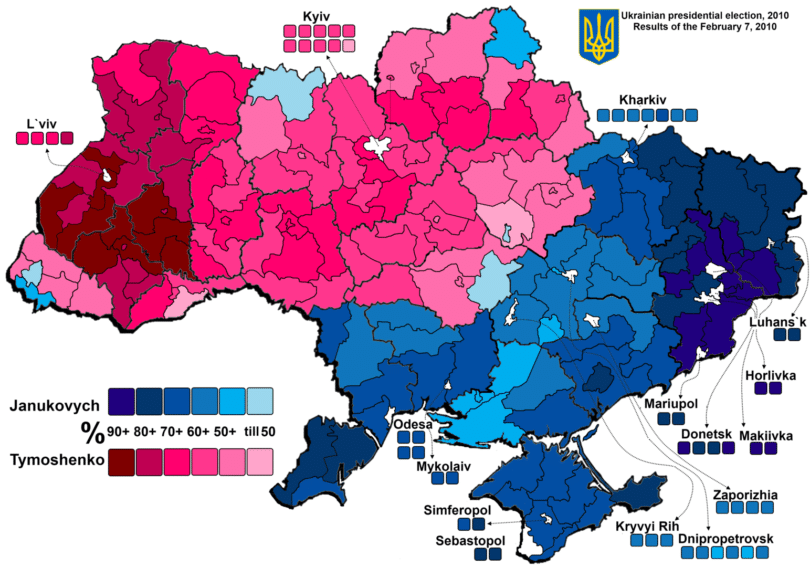
Political map of Ukraine from the 2010 elections. By Vasyl` Babych – Own work, CC BY 3.0, Link
Posted Apr 21, 2022 by Monthly Review
The following is the advance publication of the Notes from the Editors from the May 2022 issue of Monthly Review. —Eds
As we write these notes in late March 2022, the war in Ukraine continues to escalate, threatening to mutate instantaneously into a global thermonuclear war, which would result in the extermination of virtually the entire population of the earth. The nature of the current nuclear war threat and how it has reemerged in our time is the subject of the Review of Month by John Bellamy Foster in this issue, titled “‘Notes on Exterminism’ for the Twenty-First-Century Ecology and Peace Movements.”
To get a firm grasp on the current situation in Ukraine, we must understand the central role that the United States and NATO have played in the conflict from the start, beginning in 2014 with the U.S.-engineered Maidan coup. This was followed by the breaking apart of Ukraine, during which the Russian-speaking Crimea was incorporated into Russia after obtaining the population’s support in a referendum, while a civil war emerged between Kyiv, supported by the United States, and the breakaway republics in Russian-speaking Donbass in the eastern part of Ukraine, supported by Russia. Following eight years of civil war—which was again escalating in late 2021 and early 2022, with massive increases in military support and training from the United States and continued attacks by Kyiv on Donbass, in violation of the 2014 Minsk agreements—Russia entered directly into the civil war, transforming it into a full-scale war, with further horrendous results. This brought to the fore the reality that what was being played out in Ukraine was not simply a civil war between Kyiv and Donbass, which has set the stage, but rather a much larger proxy war between the United States/NATO and Russia, which has been developing for decades and lies at the root of the conflict.
As Leon Panetta, former director of the CIA (2009–11) and secretary of defense (2011-–13) under the Barack Obama administration, declared in mid–March with regard to Washington’s role in the war:
The only way to basically deal with Putin right now is to double down ourselves. Which means to provide as much military aid as necessary to the Ukrainians so that they can continue the battle against the Russians.… We are engaged in a conflict here. It is a proxy war with Russia whether we say so or not. That effectively is what is going on. And for that reason, we have to be sure we are providing as much weaponry as possible.… Make no mistake about it, diplomacy is going nowhere unless we have leverage. And the way you get leverage is by frankly going in and killing Russians. That is what the Ukrainians have to do. We have to continue the war effort.… Because this is a power game. (“U.S. Is in a Proxy War with Russia,” Bloomberg, March 17, 2022)
At the center of Panetta’s declaration here is the acknowledgment that the United States is engaged in a protracted “proxy war” with Russia, to be fought in Ukraine, with the Kyiv military forces serving as a Western proxy in a larger geopolitical struggle. The U.S./NATO role in this view is one of “providing as much weaponry as possible,” escalating the war rather than seeking diplomatic solutions.
A proxy war, in the influential definition offered by political-military strategist Andrew Mumford in 2013, is a conflict “in which a third party intervenes indirectly in order to influence the strategic outcome in favour of its preferred faction,” with the dominant third party invariably pursuing its own objectives independent of its proxy. Proxy wars are especially favored in conflicts between great powers but are often also used to achieve imperialist ends. In the case of the struggle in Ukraine, as former special advisor to the secretary of defense Colonel Douglas MacGregor has pointed out: “It looks more and more as though Ukrainians are almost incidental to the operation in the sense that they are there to impale themselves on the Russian army and die in great numbers, because the real goal of this entire thing is the destruction of the Russian state and Vladimir Putin.” Of course, the dire consequences of promoting a proxy war in Ukraine extend beyond the military to the civilian population as well (Andrew Mumford, “Proxy Warfare and the Future of Combat,” The RUSI Journal 158, no. 2 (2013): 40; Alex Rubenstein, “U.S. and NATO Allies Arm Neo-Nazis in Ukraine as Foreign Policy Elites Yearn for Afghan-Style Insurgency,” Internationalist 360°, March 20, 2022).
The U.S. proxy war in Ukraine commenced, as indicated, with the 2014 Maidan coup directed from Washington. Eight years of civil war between Kyiv and Donbass followed (briefly interrupted by the Minsk Agreements), resulting initially in the loss of some 14,000 lives. In February 2014, 130,000 Ukrainian (Kyiv) troops were on the borders of the two Donbass breakaway republics of Donetsk and Luhansk, firing into the region, where the population had already been forced to live for years in a network of underground bomb shelters (Jeremy Kuzmarov, “CIA Director William F. Burns—CAPO of World’s Biggest Spreader of Lies and Misinformation—Is Spreading the Lie that Russia’s Invasion of Ukraine Was Unprovoked,” Covert Action Magazine, March 17, 2022).
In the more than two decades from 1991 to 2014, the United States provided Kyiv with about $3.8 billion in military aid. From 2014 to 2021, direct military assistance to Kyiv was $2.4 billion, including increasingly advanced and lethal weaponry. Military assistance escalated still further with the beginning of the Joe Biden administration in 2021. Already during the Obama administration, the CIA began training Ukrainian counterinsurgency forces to fight Russians, extending this to the Azov Battalion and other neo-Nazi military groupings in Ukraine. The United Kingdom and Canada together have trained 55,000 Ukrainian troops. In November 2021, the Biden administration set up a new U.S.-Ukraine Charter on Strategic Partnership, which explicitly reiterated the goal of bringing Ukraine into NATO and set up the terms of further military support for Ukraine that would effectively promote that objective, thereby crossing red lines that Russia had established with respect to its own security. The full-scale war that broke out in late February due to the Russian intervention led to a massive pouring of weapons into Ukraine and the European theater. Thirty-two nations, almost all of them part of the NATO alliance, have provided or have promised to provide military aid to Ukraine, with billions of dollars in arms flowing into the country to feed an indefinite war (United Kingdom House of Commons, UK Military Assistance to Ukraine 2014–2021, 6–9; Rubinstein, “U.S. and NATO Allies”; “CIA Trained Ukrainian Paramilitaries,” Yahoo News, January 13, 2022; U.S. Department of State, U.S.-Ukraine Charter on Strategic Partnership, November 10, 2021).
The possibility of a diplomatic solution to the conflict is currently being strongly opposed by Washington. In these circumstances the proxy war, which on the U.S./NATO side is clearly aimed at fatally weakening if not destroying the Russian state, will likely continue, devastating Ukraine and imperiling all of humanity. It follows that all parties to the present conflict, and the world as a whole, need to focus on promoting the conditions of lasting peace through diplomacy, which requires that the vital security interests of all of the regional players be respected. Nevertheless, it is important to remind ourselves that this is an intercapitalist war with all the dangers that such a situation portends. The long struggle for world peace requires a shift to socialism (James Politi, “U.S. Dampens Hopes for Diplomatic Solution to Ukraine Crisis with Russia,” February 14, 2022; James Politi, “U.S. Pours Cold Water on Hopes of Diplomatic Solution in Ukraine,” Financial Times, March 17, 2022).
https://mronline.org/2022/04/21/the-civ ... offensive/



